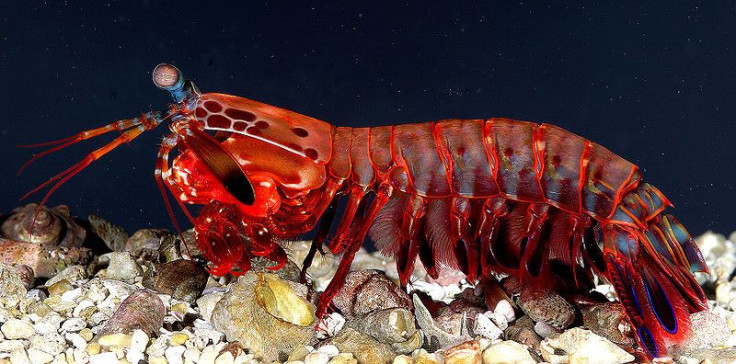Shrimp With Super Strong Punch Inspires ‘Advanced’ Biomaterial That’s Tougher Than A Football Helmet

Engineers developing a new, supertough material drew inspiration from a curious source: a crustacean called the mantis shrimp.
What was it about the mantis shrimp that researchers found so inspiring? The shrimp has an incredibly strong appendage, like a medieval club, that it uses to bludgeon its prey to death. The shrimp can strike objects thousands of times without breaking it and with a force more than 1,000 times its own weight. Most astonishing, the fist-like club accelerates faster than a .22-caliber bullet. It’s so quick it actually boils the water around it, according to researchers.
But it’s not the superhero characteristics of the mantis' club in which the researchers from the University of California at Riverside, which is part of the University of Southern California, and Purdue University, are most interested. It’s the structure of the club that makes the shrimp’s punch so powerful. The club has a spiraling arrangement of mineralized fiber layers that acts like a shock absorber.
The new study, published in the journal Acta Biomaterialia, notes how each layer of the club is rotated at a slight angle from the layer before it. Eventually the structure makes a complete 180. Using this design, researchers developed a structure that involves carbon fiber-epoxy composites, an extremely strong and light polymer commonly used in the transportation industry. The result is a material that they say is more impact-resistant and tougher than other supertough materials that are out there, including those typically used in airplanes.
“Biology has an incredible diversity of species, which can provide us new design cues and synthetic routes to the next generation of advanced materials for light-weight automobiles, aircraft and other structural applications,” study researcher David Kisailus, a professor of engineering at the University of California, Riverside, said in a statement.
Researchers say the material could even be applied to things like body armor and football helmets.
To test the durability of the material, researchers performed several impact experiments that involved dropping weights onto it and measuring the damage they caused. They found that the structure of their material was 15 to 20 percent stronger than similar materials.
Funding for the research came from the Air Force Office of Scientific Research and the National Science Foundation.
Scientists have long taken cues from nature for developing new products, but the study has particularly gained momentum in the past few decades. It’s part of a burgeoning field of research known as biomimetics, described by scientist and author Janine Benyus as a “new science that studies nature's models and then imitates or takes inspiration from these designs and processes to solve human problems.”
In March, researchers studied the structure of a certain oyster shell while developing a “natural exoskeleton” for U.S. soldiers. The result was a material that was lightweight and incredibly resistant to penetration.
Here’s the mantis shrimp in action:
© Copyright IBTimes 2024. All rights reserved.






















